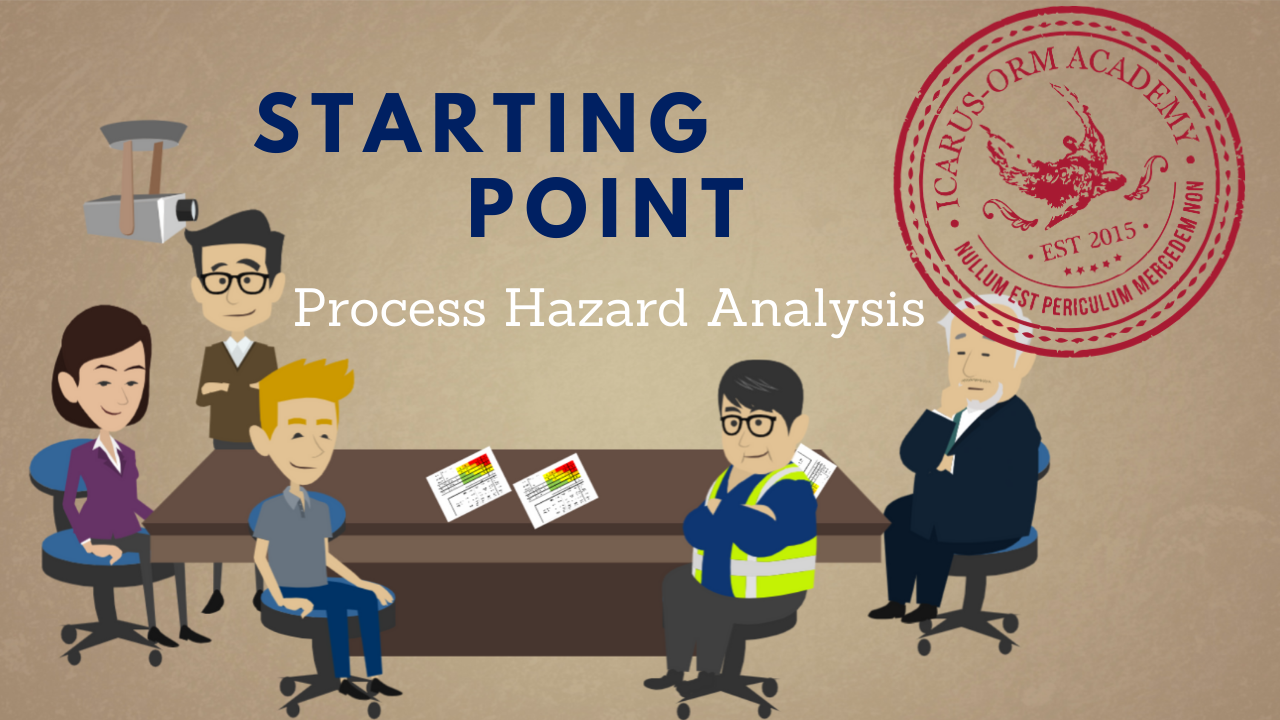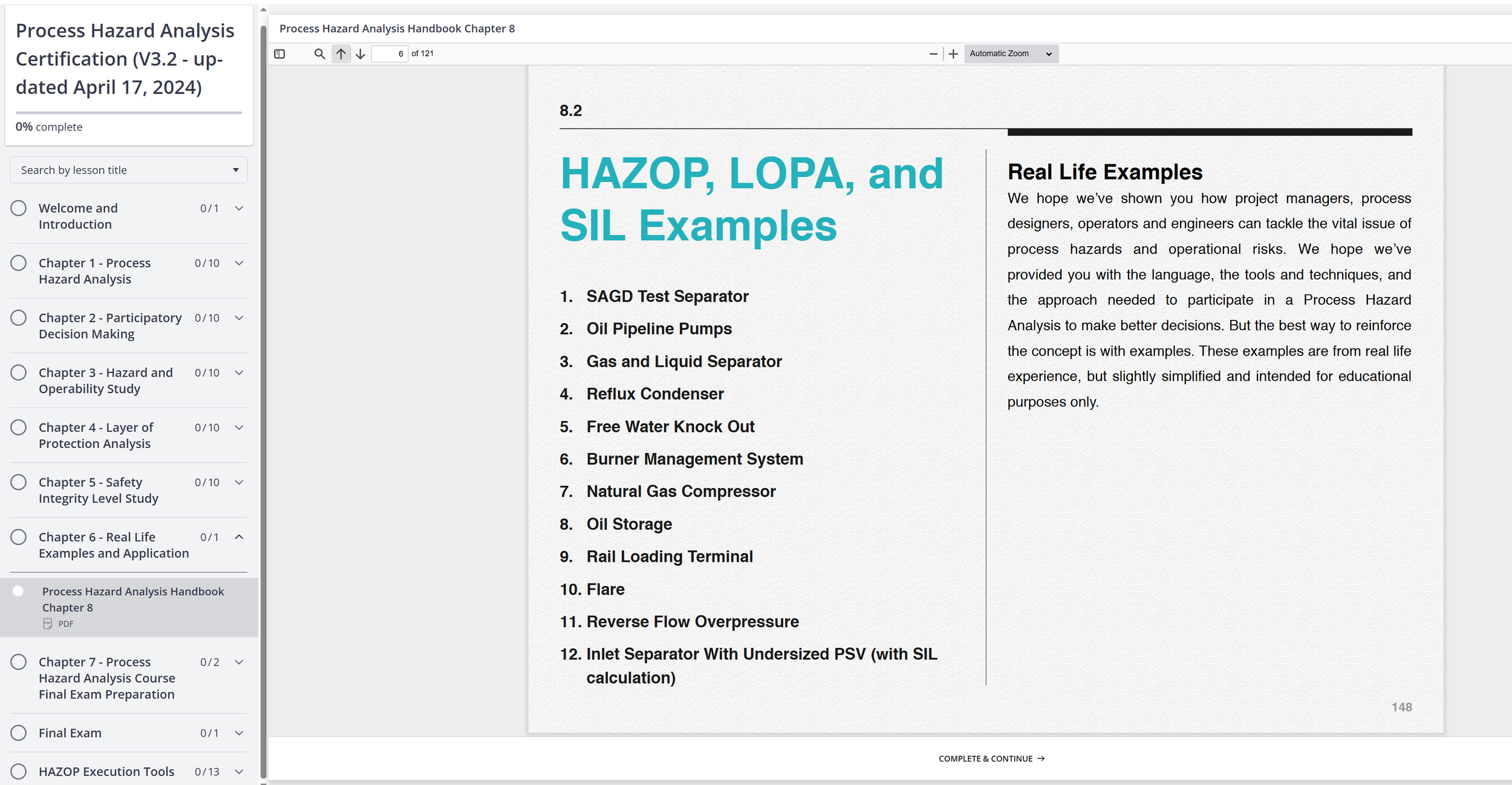PHA Certification Course
Access to our interactive Process Hazard Analysis Certification with course exclusive videos and quizzes taken at your own pace.
Make risk-based decision in a Process Hazard Analysis that work for the project and create value in operation.
Identify, assess and manage risk based on Process Hazard Analysis methodologies practiced by the world’s leading organizations and recognized by IEC and ISA standards.
More than a physical on-site class
Whether you are a process engineer, control room operator or project manager, you’ll be taking your decision-making skills to the next level with this course. Each lesson is designed to be extremely practical, visual and fun. In addition, you can learn the content on your own time rather than in a compressed schedule. You also don’t have to leave your office to attend a physical class, because this course covers all the content and more.
Real world examples and techniques that you can apply tomorrow
Developed by the author of the Process Hazard Analysis Handbook, a TÜV Functional Safety Engineer and IEC 61508 standard committee member, this online course incorporates real world learning from experiences with thousands of practitioners in all types of industrial processes around the world. If you’re looking for the best place to apply the powerful techniques of HAZOP, LOPA and SIL studies, start with this course today.
Applied by the biggest corporations
You will be learning how to use the proven HAZOP, LOPA and SIL study methodologies used by successful companies worldwide. Learn the techniques and concepts that are used for both brownfield and greenfield projects. Both project and operation teams have discovered and changed the way they think about process safety.
Course Outline
Chapter 1 - Process Hazard Analysis
-
We’ll begin by understanding what a Process Hazard Analysis (PHA) is, and how it benefits a company to achieve long-term goals.
-
We need to recognize the importance of making risk-based decisions, and how each decision can impact the company as a whole.
-
When talking about risk, there will always be an element of uncertainty, so it is critical to communicate probability concepts using quantitative, unambiguous terms.
Chapter 2 - Participatory Decision Making
-
Next, we want to explore how a team of participants can make decisions using a consistent decision framework, which will ultimately drive value in an organization.
-
This section outlines six measures of decision quality, and contrasts poor decisions with excellent ones.
-
Everyone can be subject to biases. We’ll see how an individual’s surroundings, culture, and experiences can affect the way decisions are made in a Process Hazard Analysis.
Chapter 3 - Hazard and Operability (HAZOP)
-
We’ll explore a widely-used methodology within the industrial processes: a Hazard and Operability study (HAZOP). We will understand the advantages of a HAZOP and why it is used as the baseline for many PHAs to identify and assess risk.
-
This section breaks down the HAZOP into 8 simple building blocks, equipping you with the basics on how the HAZOP is conducted and what information is needed for a successful HAZOP.
-
Join our very own PHA team in a HAZOP while they review a proposed design. In this demonstration you’ll see some typical scenarios encountered during a HAZOP, including common pitfalls and ways to overcome them.
Chapter 4 - Layer of Protection Analysis (LOPA)
-
We’ll take a look at another PHA methodology which complements the HAZOP. By using a Layer of Protection Analysis (LOPA), you can make decisions on high severity scenarios with more confidence.
-
A LOPA can be broken down into 9 simple building blocks, outlining how a LOPA is performed and the required information to reach a decision point for any high severity scenario.
-
Re-join the PHA team from the HAZOP demonstration and see how a LOPA is used to enhance decisions by examining a hazardous scenario with critical consequences.
Chapter 5 - Safety Integrity Level (SIL Study)
-
Safety Integrity Level is a way to describe the reliability of an automated safety instrumented function. We’ll understand how it relates to a HAZOP and LOPA, what it means to have a SIL-rated safety instrumented function, and how conducting a SIL study creates long-term value.
-
Learn how to determine the reliability of a safety instrumented function and how it is incorporated into operationally sustainable decisions.
-
Join the PHA team one last time for the conclusion of the scenario from the HAZOP and LOPA demonstrations. We will see the completion of our hazardous scenario, and how the SIL study can help us bring a facility’s risk to an acceptable level.
Chapter 6 - Real Life Examples and Application
Examples from real processes highlighting how to complete HAZOP and LOPA scenarios and perform SIL calculations.
Process Hazard Analysis Certification Exam
The last step to earn your certification is to demonstrate your ability to think logically and your understanding of high quality risk-based decisions.
HAZOP Execution Tools
Tips and tricks on how to be an effective facilitator and execute a PHA to achieve good outcomes and make informed decisions.






